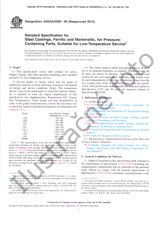Potrebujeme váš súhlas na využitie jednotlivých dát, aby sa vám okrem iného mohli ukazovať informácie týkajúce sa vašich záujmov. Súhlas udelíte kliknutím na tlačidlo „OK“.
ASTM F3418-20
Standard Test Method for Measurement of Transition Temperatures of Slack Waxes used in Equine Sports Surfaces by Differential Scanning Calorimetry (DSC)
NORMA vydaná dňa 1.1.2020
Informácie o norme:
Označenie normy: ASTM F3418-20
Dátum vydania normy: 1.1.2020
Kód tovaru: NS-982878
Počet strán: 4
Približná hmotnosť: 12 g (0.03 libier)
Krajina: Americká technická norma
Kategória: Technické normy ASTM
Anotácia textu normy ASTM F3418-20 :
Keywords:
binder, thermal properties, differential scanning calorimetry, petroleum wax, transition temperature,
Doplňujúce informácie
| Significance and Use |
|
5.1 DSC is a convenient and rapid method for determining the temperature limits within which a wax undergoes during transitions. The highest temperature transition is a solid-liquid transition associated with complete melting; it can guide the choice of wax binders used in synthetic equine sports surfaces, provide information on the effect of operational track temperatures on binder melting, as well as giving indications of changes in the binder over time. The solid-solid temperature transition is related to the properties of the solid, that is, hardness and blocking temperature, although these slack wax-wax based binders typically contain oil contents greater that 20 % by mass and consequently are not in a hardened state unless subjected to very cold temperatures (well below –17 °C). Note 2: For a relatively narrow cut petroleum wax, the lowest
transition will be a solid-solid transition. A narrow cut wax is
one obtained by de-oiling a single petroleum distillate with a
maximum range of 49 °CF between its 5 and 95 % vol in accordance
with Test Method D1160
boiling points (converted to 760 torr). The DSC method cannot
differentiate between solid-liquid and solid-solid transitions.
Such information must be predetermined by other techniques. In the
case of blends, the lower temperature transition may be envelopes
of both solid-liquid and solid-solid transitions.
5.2 Since petroleum wax is a mixture of hydrocarbons with different molecular weights, its transitions occur over a temperature range. This range is one factor that influences the width, expressed in degrees Celsius, of the DSC peaks. The highest temperature transition is a first-order transition. If, for a series of waxes, there is supporting evidence that the highest temperature transition of each wax is the major first-order transition, its relative width should correlate with the relative width of the wax’s molecular weight distribution. |
| 1. Scope |
|
1.1 The slack waxes typically used in equestrian surfaces comprise a blend of different waxes and oils containing a variety of hydrocarbons, chain lengths and structures. 1.2 The blend of wax and oil determines the mechanical properties of the surface material as well as the response of the wax to temperature. The combination of lower and higher carbon weight materials, oil content and hydrocarbon structures also control how the wax will change over time. 1.3 The differential scanning calorimetry (DSC) test is used to determine temperature transitions and melting range of wax samples. DSC can therefore demonstrate differences in heat flow rates between extracted wax samples. The wax samples are extracted from samples of the surface materials and used in a standard test based on Test Method D4419 (1.4 This standard does not purport to address all of the safety concerns, if any, associated with its use. It is the responsibility of the user of this standard to establish appropriate safety, health, and environmental practices and determine the applicability of regulatory limitations prior to use. 1.5 This international standard was developed in accordance with internationally recognized principles on standardization established in the Decision on Principles for the Development of International Standards, Guides and Recommendations issued by the World Trade Organization Technical Barriers to Trade (TBT) Committee. |




 Cookies
Cookies
